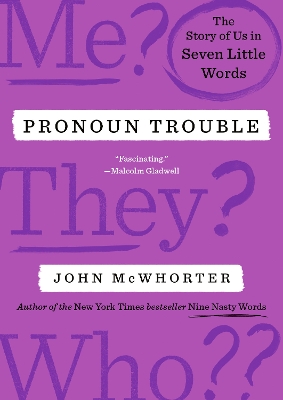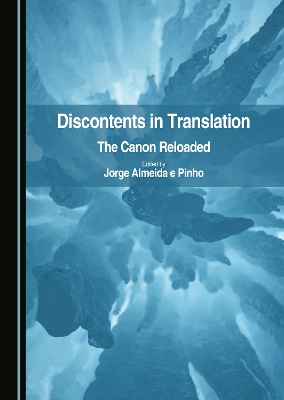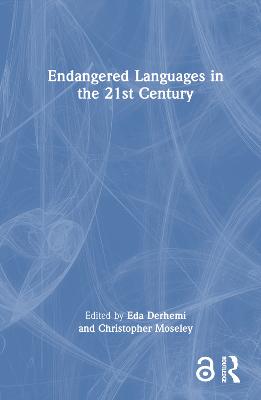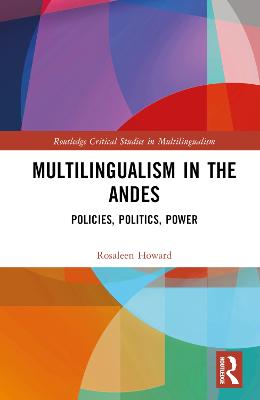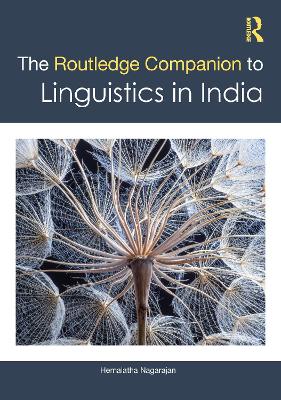Endangered Languages in the 21st Century
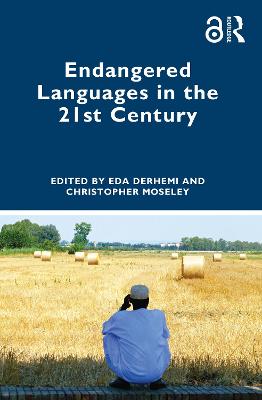 portes grátis
portes grátis
Endangered Languages in the 21st Century
Derhemi, Eda; Moseley, Christopher
Taylor & Francis Ltd
02/2023
318
Mole
Inglês
9781032196749
15 a 20 dias
Descrição não disponível.
List of contributors
1. Foreword and Introduction by David Crystal
Section I: General state of endangered languages today in some large regions of the world: some good news
2. Michael Walsh: The rise and rise of Australian languages
3. Sebastian Drude, Joshua Birchall, Ana Vilacy Galucio Moreira, Denny Moore, Hein van der Voort: Endangered languages in Brazil in 2021
4. Hakim Elnazarov: Endangered languages of Central Asia: Challenges and prospects for development in the new millennium
5. Salem Mezhoud: They kill languages, don't they? - a short chronicle of planned language death in North Africa
6. Mary Jane Norris & Robert Adcock: First- and second-language speakers in the home: an Indigenous Canadian perspective
Section II: Theoretical approaches - supporting language maintenance
7. M. Paul Lewis: Sustaining language use: Bridging the gap between language communities and linguists
8. David Bradley: Language endangerment: what it is, how to measure it and how to act
9. Tjeerd de Graaf: The use of historical material for the safeguarding of endangered languages
10. Riitta Valijaervi & Lily Kahn: The role of new media in endangered language communities
11. Eda Derhemi: Examining change in endangered languages with some reference to Arberesh and Arvanitika
12. Christopher Moseley: Transnational languages in the Atlas of Endangered languages
13. Simon Musgrave & Nick Thieberger: Hypothetically speaking: Ethic in linguistic fieldwork, a provocation
Section III: Empirical studies: towards sustainable language maintenance and use
14. Rob Amery: Sustainable pathways for a fledgling language movement: the case of Kaurna of the Adelaide Plains, South Australia
15. Bernard Spolsky: The fate of Jewish languages competing with revitalised Hebrew
16. Peter Austin: Making 2,180 pages more useful: the Diyari dictionary of Rev. J. G. Reuther
17. David Nash: An unusual kind of loanshift: loan homonyms in some Australian endangered languages
18. Maya David: Sindhi Hindhus - a diasporic community: determining reasons for language shift and aligning it with revitalisation strategies
19. Marleen Haboud & Fernando Ortega: The Waotedodo language and the effects of intense contact
Index
1. Foreword and Introduction by David Crystal
Section I: General state of endangered languages today in some large regions of the world: some good news
2. Michael Walsh: The rise and rise of Australian languages
3. Sebastian Drude, Joshua Birchall, Ana Vilacy Galucio Moreira, Denny Moore, Hein van der Voort: Endangered languages in Brazil in 2021
4. Hakim Elnazarov: Endangered languages of Central Asia: Challenges and prospects for development in the new millennium
5. Salem Mezhoud: They kill languages, don't they? - a short chronicle of planned language death in North Africa
6. Mary Jane Norris & Robert Adcock: First- and second-language speakers in the home: an Indigenous Canadian perspective
Section II: Theoretical approaches - supporting language maintenance
7. M. Paul Lewis: Sustaining language use: Bridging the gap between language communities and linguists
8. David Bradley: Language endangerment: what it is, how to measure it and how to act
9. Tjeerd de Graaf: The use of historical material for the safeguarding of endangered languages
10. Riitta Valijaervi & Lily Kahn: The role of new media in endangered language communities
11. Eda Derhemi: Examining change in endangered languages with some reference to Arberesh and Arvanitika
12. Christopher Moseley: Transnational languages in the Atlas of Endangered languages
13. Simon Musgrave & Nick Thieberger: Hypothetically speaking: Ethic in linguistic fieldwork, a provocation
Section III: Empirical studies: towards sustainable language maintenance and use
14. Rob Amery: Sustainable pathways for a fledgling language movement: the case of Kaurna of the Adelaide Plains, South Australia
15. Bernard Spolsky: The fate of Jewish languages competing with revitalised Hebrew
16. Peter Austin: Making 2,180 pages more useful: the Diyari dictionary of Rev. J. G. Reuther
17. David Nash: An unusual kind of loanshift: loan homonyms in some Australian endangered languages
18. Maya David: Sindhi Hindhus - a diasporic community: determining reasons for language shift and aligning it with revitalisation strategies
19. Marleen Haboud & Fernando Ortega: The Waotedodo language and the effects of intense contact
Index
Este título pertence ao(s) assunto(s) indicados(s). Para ver outros títulos clique no assunto desejado.
Australian Linguistic Society;Severely Endangered;Home Language Users;Kaurna Language;Endangered Languages Project;Endangered Languages;UNESCO Atlas;Language Revitalization;Endangered Language Communities;Van Der Voort;Intergenerational Language Transmission;Museu Goeldi;Modern Israeli Hebrew;Secondary Home Users;Post-secondary Education;Pamiri Languages;Certificate Iii;Heritage Language;Supporting Language Maintenance;Indigenous Languages;Language Death;Kaurna People;Main Home Language;EGIDS;Accusative Marker
List of contributors
1. Foreword and Introduction by David Crystal
Section I: General state of endangered languages today in some large regions of the world: some good news
2. Michael Walsh: The rise and rise of Australian languages
3. Sebastian Drude, Joshua Birchall, Ana Vilacy Galucio Moreira, Denny Moore, Hein van der Voort: Endangered languages in Brazil in 2021
4. Hakim Elnazarov: Endangered languages of Central Asia: Challenges and prospects for development in the new millennium
5. Salem Mezhoud: They kill languages, don't they? - a short chronicle of planned language death in North Africa
6. Mary Jane Norris & Robert Adcock: First- and second-language speakers in the home: an Indigenous Canadian perspective
Section II: Theoretical approaches - supporting language maintenance
7. M. Paul Lewis: Sustaining language use: Bridging the gap between language communities and linguists
8. David Bradley: Language endangerment: what it is, how to measure it and how to act
9. Tjeerd de Graaf: The use of historical material for the safeguarding of endangered languages
10. Riitta Valijaervi & Lily Kahn: The role of new media in endangered language communities
11. Eda Derhemi: Examining change in endangered languages with some reference to Arberesh and Arvanitika
12. Christopher Moseley: Transnational languages in the Atlas of Endangered languages
13. Simon Musgrave & Nick Thieberger: Hypothetically speaking: Ethic in linguistic fieldwork, a provocation
Section III: Empirical studies: towards sustainable language maintenance and use
14. Rob Amery: Sustainable pathways for a fledgling language movement: the case of Kaurna of the Adelaide Plains, South Australia
15. Bernard Spolsky: The fate of Jewish languages competing with revitalised Hebrew
16. Peter Austin: Making 2,180 pages more useful: the Diyari dictionary of Rev. J. G. Reuther
17. David Nash: An unusual kind of loanshift: loan homonyms in some Australian endangered languages
18. Maya David: Sindhi Hindhus - a diasporic community: determining reasons for language shift and aligning it with revitalisation strategies
19. Marleen Haboud & Fernando Ortega: The Waotedodo language and the effects of intense contact
Index
1. Foreword and Introduction by David Crystal
Section I: General state of endangered languages today in some large regions of the world: some good news
2. Michael Walsh: The rise and rise of Australian languages
3. Sebastian Drude, Joshua Birchall, Ana Vilacy Galucio Moreira, Denny Moore, Hein van der Voort: Endangered languages in Brazil in 2021
4. Hakim Elnazarov: Endangered languages of Central Asia: Challenges and prospects for development in the new millennium
5. Salem Mezhoud: They kill languages, don't they? - a short chronicle of planned language death in North Africa
6. Mary Jane Norris & Robert Adcock: First- and second-language speakers in the home: an Indigenous Canadian perspective
Section II: Theoretical approaches - supporting language maintenance
7. M. Paul Lewis: Sustaining language use: Bridging the gap between language communities and linguists
8. David Bradley: Language endangerment: what it is, how to measure it and how to act
9. Tjeerd de Graaf: The use of historical material for the safeguarding of endangered languages
10. Riitta Valijaervi & Lily Kahn: The role of new media in endangered language communities
11. Eda Derhemi: Examining change in endangered languages with some reference to Arberesh and Arvanitika
12. Christopher Moseley: Transnational languages in the Atlas of Endangered languages
13. Simon Musgrave & Nick Thieberger: Hypothetically speaking: Ethic in linguistic fieldwork, a provocation
Section III: Empirical studies: towards sustainable language maintenance and use
14. Rob Amery: Sustainable pathways for a fledgling language movement: the case of Kaurna of the Adelaide Plains, South Australia
15. Bernard Spolsky: The fate of Jewish languages competing with revitalised Hebrew
16. Peter Austin: Making 2,180 pages more useful: the Diyari dictionary of Rev. J. G. Reuther
17. David Nash: An unusual kind of loanshift: loan homonyms in some Australian endangered languages
18. Maya David: Sindhi Hindhus - a diasporic community: determining reasons for language shift and aligning it with revitalisation strategies
19. Marleen Haboud & Fernando Ortega: The Waotedodo language and the effects of intense contact
Index
Este título pertence ao(s) assunto(s) indicados(s). Para ver outros títulos clique no assunto desejado.
Australian Linguistic Society;Severely Endangered;Home Language Users;Kaurna Language;Endangered Languages Project;Endangered Languages;UNESCO Atlas;Language Revitalization;Endangered Language Communities;Van Der Voort;Intergenerational Language Transmission;Museu Goeldi;Modern Israeli Hebrew;Secondary Home Users;Post-secondary Education;Pamiri Languages;Certificate Iii;Heritage Language;Supporting Language Maintenance;Indigenous Languages;Language Death;Kaurna People;Main Home Language;EGIDS;Accusative Marker


